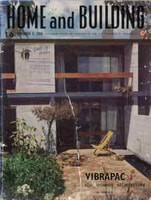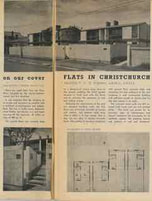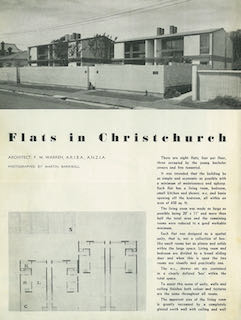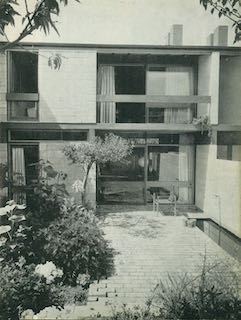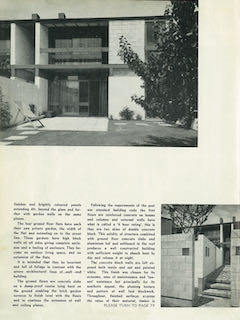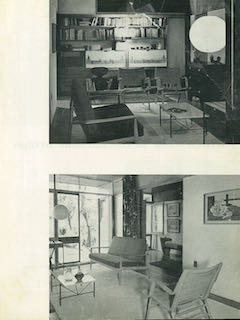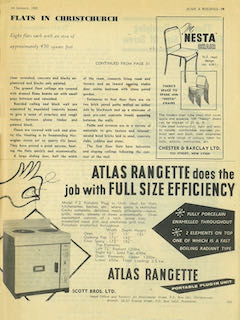Dorset Street Flats appeared twice in ""Home And Building" in 1959, once in January as a full 5-page illustrated feature, and again in September, this time taking the magazine cover, in an abridged 2-page version promoting Vibrapac concrete blocks. The magazine was published under the auspices of the New Zealand Institute of Architects (N.Z.I.A.) from 1937 to 1975.
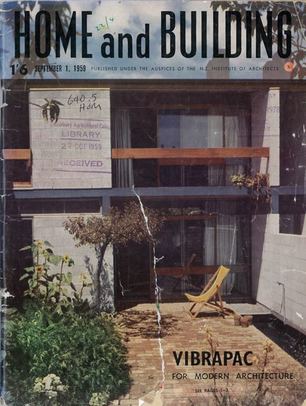
Cover story of "Home And Building", September 1959.
FLATS IN CHRISTCHURCH
ARCHITECT: F.M. WARREN, A.R.I.B.A., A.N.Z.I.A.
There are eight flats, four per floor, three occupied by the young bachelor owners and five tenanted.
It was intended that the building be as simple and economic as possible with a minimum of maintenance and upkeep. Each flat has a living room, bedroom, small kitchen and shower, w.c. and basin opening off the bedroom, all within an area of 450 sq. ft.
The ground floors are concrete slabs on a damp-proof course lying hard on the ground enabling the brick garden terraces to finish level with the floors and to continue the extension of wall and ceiling planes.
Following the requirements of the post war standard building code, the first floors are reinforced concrete on beams and columns and external walls have what is called a ‘4 hour rating’, that is they are two skins of double concrete block. This solidity of structure combined with ground floor concrete slabs and aluminium foil and softboard in the roof produces a well constructed building with sufficient weight to absorb heat by day and release it at night.
The concrete block walls are left exposed both inside and out and painted white. This finish was chosen for its economy, ease of maintenance and ‘tenant’ resistance but principally for its aesthetic appeal, the pleasing texture and pattern of well laid blockwork.
“Home And Building”, 1 September 1959, pp 2-3.
Reproduced with the permission of the publisher.
FLATS IN CHRISTCHURCH
ARCHITECT: F.M. WARREN, A.R.I.B.A., A.N.Z.I.A.
There are eight flats, four per floor, three occupied by the young bachelor owners and five tenanted.
It was intended that the building be as simple and economic as possible with a minimum of maintenance and upkeep. Each flat has a living room, bedroom, small kitchen and shower, w.c. and basin opening off the bedroom, all within an area of 450 sq. ft.
The ground floors are concrete slabs on a damp-proof course lying hard on the ground enabling the brick garden terraces to finish level with the floors and to continue the extension of wall and ceiling planes.
Following the requirements of the post war standard building code, the first floors are reinforced concrete on beams and columns and external walls have what is called a ‘4 hour rating’, that is they are two skins of double concrete block. This solidity of structure combined with ground floor concrete slabs and aluminium foil and softboard in the roof produces a well constructed building with sufficient weight to absorb heat by day and release it at night.
The concrete block walls are left exposed both inside and out and painted white. This finish was chosen for its economy, ease of maintenance and ‘tenant’ resistance but principally for its aesthetic appeal, the pleasing texture and pattern of well laid blockwork.
“Home And Building”, 1 September 1959, pp 2-3.
Reproduced with the permission of the publisher.
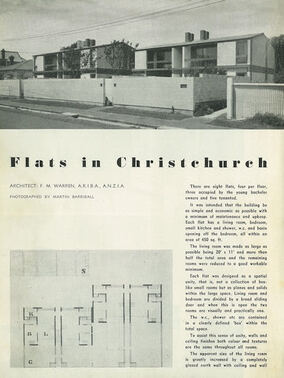
Feature story in "Home And Building", January 1959.
FLATS IN CHRISTCHURCH
ARCHITECT: F.M. WARREN, A.R.I.B.A., A.N.Z.I.A.
PHOTOGRAPHED BY MARTIN BARRIBALL
There are eight flats, four per floor, three occupied by the young bachelor owners and five tenanted.
It was intended that the building be as simple and economic as possible with a minimum of maintenance and upkeep. Each flat has a living room, bedroom, small kitchen and shower, w.c. and basin opening off the bedroom, all within an area of 450 sq. ft.
The living room was made as large as possible being 20’ x 11’ and more than half the total area and the remaining rooms were reduced to a good workable minimum.
Each flat was designed as a spatial unity, the is, not a collection of box-like small rooms but as planes and solids within the large space. Living room and bedroom are divided by a broad sliding door and when this is open the two rooms are visually and practically one.
The w.c., shower etc. are contained in a clearly defined ‘box’ within the total space.
To assist this sense of unity, walls and ceiling finishes both colour and textures are the same throughout all rooms.
The apparent size of the living room is greatly increased by a completely glazed north wall with ceiling and wall finishes and brightly coloured panels extending 4ft. beyond the glass and further with garden walls on the same plane.
The four ground floor flats have each their own private garden, the width of the flat and extending on to the street line. These gardens have high block walls on all sides giving complete seclusion and a feeling of enclosure. They become an outdoor living space, and an extension of the flats.
It is intended that they be luxuriant and full of foliage in contrast with the severe architectural lines of wall and building.
The ground floors are concrete slabs on a damp-proof course lying hard on the ground enabling the brick garden terraces to finish level with the floors and to continue the extension of wall and ceiling planes.
Following the requirements of the post war standard building code the first floors are reinforced concrete on beams and columns and external walls have what is called a ‘4 hour rating’, that is they are two skins of double concrete block. This solidity of structure combined with ground floor concrete slabs and aluminium foil and softboard in the roof produces a well constructed building with sufficient weight to absorb heat by day and release it at night.
The concrete block walls are left exposed both inside and out and painted white. This finish was chosen for its economy, ease of maintenance and ‘tenant’ resistance but principally for its aesthetic appeal, the pleasing texture and pattern of well laid blockwork. Throughout, finished surfaces express the value of their material, timber is clear varnished, concrete and blocks unaltered and blocks only painted.
The group floor ceilings are covered with dressed Rimu boards set with small gaps between and varnished.
Boarded ceiling and block wall are separated by unpainted concrete beams to give a sense of structure and rough texture between glossy timber and painted block.
Floors are covered with cork and plastic tile. Heating is by freestanding Norwegian stoves set on quarry tile bases. They have proved a great success, heating the flats quickly and economically.
A large sliding door, half the width of the room, connects living room and terrace and an inward opening stable door unites bedroom with stone paved garden.
Entrances to first floor flats are via two brick paved paths walled on either side by clockwork and up a staircase of open pre-cast concrete treads spanning between the walls.
Paths and terraces are in a variety of materials to give texture and interest: second hand bricks laid in sand, concrete slabs, cobbles and stone.
The first floor flats have balconies and sloping ceilings following the contour of the roof.
“Home And Building”, 1 January 1959, pp 28-31, 79.
Reproduced with the permission of the publisher.
FLATS IN CHRISTCHURCH
ARCHITECT: F.M. WARREN, A.R.I.B.A., A.N.Z.I.A.
PHOTOGRAPHED BY MARTIN BARRIBALL
There are eight flats, four per floor, three occupied by the young bachelor owners and five tenanted.
It was intended that the building be as simple and economic as possible with a minimum of maintenance and upkeep. Each flat has a living room, bedroom, small kitchen and shower, w.c. and basin opening off the bedroom, all within an area of 450 sq. ft.
The living room was made as large as possible being 20’ x 11’ and more than half the total area and the remaining rooms were reduced to a good workable minimum.
Each flat was designed as a spatial unity, the is, not a collection of box-like small rooms but as planes and solids within the large space. Living room and bedroom are divided by a broad sliding door and when this is open the two rooms are visually and practically one.
The w.c., shower etc. are contained in a clearly defined ‘box’ within the total space.
To assist this sense of unity, walls and ceiling finishes both colour and textures are the same throughout all rooms.
The apparent size of the living room is greatly increased by a completely glazed north wall with ceiling and wall finishes and brightly coloured panels extending 4ft. beyond the glass and further with garden walls on the same plane.
The four ground floor flats have each their own private garden, the width of the flat and extending on to the street line. These gardens have high block walls on all sides giving complete seclusion and a feeling of enclosure. They become an outdoor living space, and an extension of the flats.
It is intended that they be luxuriant and full of foliage in contrast with the severe architectural lines of wall and building.
The ground floors are concrete slabs on a damp-proof course lying hard on the ground enabling the brick garden terraces to finish level with the floors and to continue the extension of wall and ceiling planes.
Following the requirements of the post war standard building code the first floors are reinforced concrete on beams and columns and external walls have what is called a ‘4 hour rating’, that is they are two skins of double concrete block. This solidity of structure combined with ground floor concrete slabs and aluminium foil and softboard in the roof produces a well constructed building with sufficient weight to absorb heat by day and release it at night.
The concrete block walls are left exposed both inside and out and painted white. This finish was chosen for its economy, ease of maintenance and ‘tenant’ resistance but principally for its aesthetic appeal, the pleasing texture and pattern of well laid blockwork. Throughout, finished surfaces express the value of their material, timber is clear varnished, concrete and blocks unaltered and blocks only painted.
The group floor ceilings are covered with dressed Rimu boards set with small gaps between and varnished.
Boarded ceiling and block wall are separated by unpainted concrete beams to give a sense of structure and rough texture between glossy timber and painted block.
Floors are covered with cork and plastic tile. Heating is by freestanding Norwegian stoves set on quarry tile bases. They have proved a great success, heating the flats quickly and economically.
A large sliding door, half the width of the room, connects living room and terrace and an inward opening stable door unites bedroom with stone paved garden.
Entrances to first floor flats are via two brick paved paths walled on either side by clockwork and up a staircase of open pre-cast concrete treads spanning between the walls.
Paths and terraces are in a variety of materials to give texture and interest: second hand bricks laid in sand, concrete slabs, cobbles and stone.
The first floor flats have balconies and sloping ceilings following the contour of the roof.
“Home And Building”, 1 January 1959, pp 28-31, 79.
Reproduced with the permission of the publisher.

